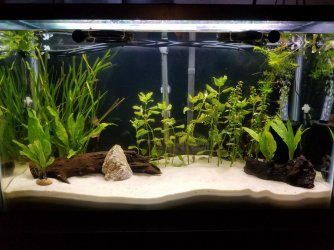These are the lights. https://www.amazon.com/gp/product/B086SV999T/?tag=ff0d01-20Diatoms are normal in new tanks, it takes a few months for a new aquarium to become biologically stable. And keep in mind that every "tweak" you do impacts this process, so jumping into doing this or dumping in that usually doesn't help unless it is correcting an actual problem.
I would use a comprehensive fertilizer minimally but nothing else (meaning, don't add nutrient "x" or something). Lighting may need adjusting, I don't know what type it is, what spectrum, or what duration now...these all matter. Along with the total plants (a photo of the entire tank would help with this). Having said that,tank lighting on more than around 8 hours is often excessive, so this is a possibility.
If you do adjustments, remember it takes a couple of weeks to see results. Rapid changes to this and that only throw the system off-balance more.
I'll post a picture a little later.
It's a dynamic process. I'm still adding plants and then I'll add the livestock. I realize that it's not going to be a perfectly smooth transition but I would like to control the algae as best I can along the way.


